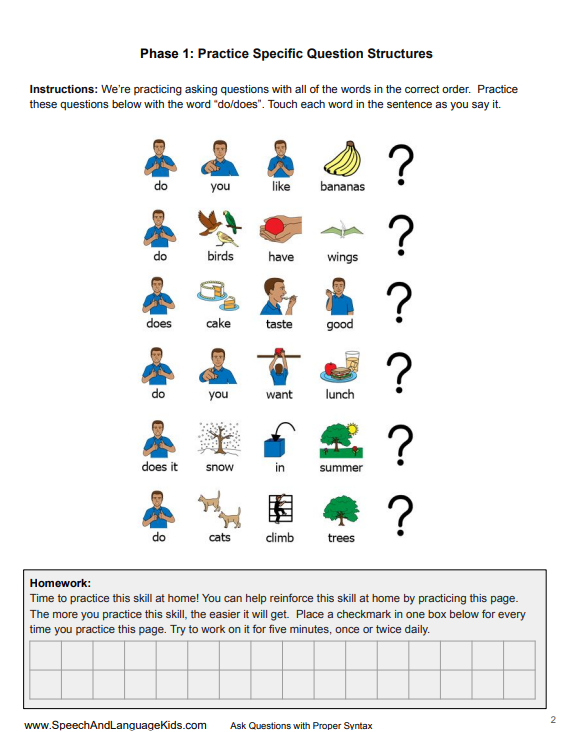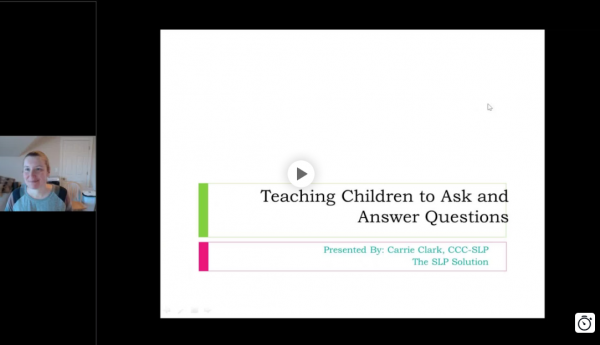Asking Questions Speech Therapy:
How to Teach a Child to Ask Questions with Correct Word Order
For many children with language delays, asking questions appropriately can be very confusing to figure out. As adults, we change the word order of a sentence when asking questions. For example, instead of saying “you do have three apples”, we would ask a question as “do you have three apples?” Often, children with language delays will miss this subtle word order shift and will simply ask the question without changing the word order. When they are asking questions, it may sound like “I can have one?” or “you are eating cookies?”. This can make their message difficult to follow and, if they don’t get the right intonational patterns, you may not even know that they’re asking questions at all.
Asking Questions Step One:
Collecting an Inventory of Incorrect Question Structures
The first thing you will need to do is identify which structures your child is having trouble with. We will do this by collecting an inventory. Take a week to listen for times that your child asks a question with the incorrect word order. Every time you hear one, write it down. You can jot notes on your smart phone or just keep a small pad of paper with you and write them down when you hear them. I’ve also had parents call their landline house phone and leave a voicemail message of what it was so they could write it down when they got home. However you need to do it, just keep a list. I recommend doing this for a week or so because it may take a while to change your mindset so that you catch them. As parents, we tend to interpret what our children say and may not notice when they use incorrect word order. Once you have a pretty good-sized list, go through it and see if you can figure out a few different types of questions that your child keeps having trouble with. Maybe she has trouble asking “do” questions, like “do you have ___” or “do you want to ____”. Or maybe, she has trouble with “is” questions, like “is she coming” or “what is she eating?”. Look through the list and come up with some patterns. Choose the most common question forms to target during step two.
Asking Questions Step Two:
Imitating and Practicing Correct Question Structures
Now that you’ve chosen a few question structures to target, you will want to have your child imitate and practice those structures during a game or activity. Think of a game or activity that would give your child multiple opportunities to ask questions with that structure. You may have to create your own game that provides opportunities. Play this game while having your child imitate the correct question structure over and over again. Make sure he has many chances to practice the question. Here are some ideas of how you can do this for various question forms:
- Do Questions: Play Go Fish with your child! On each turn, your child will need to ask “do you have a ___?”.
- Is Questions: Take turns asking each other about what people are doing in pictures. Each turn, someone asks “is he ___-ing?” and the other person must answer. Do this before each turn in a board game or while doing something else fun.
- Mixed Does and Is: Play 20 questions. Tell your child you’re thinking of something and have him practice asking questions to figure out what it is. Help him form the questions correctly.
- Are Questions: Get out a car or other vehicle and a few other toys. Tell your child you’re thinking of a place to go. Have your child ask “are you going ____” until he guesses correctly. You can also do this with other actions by having him guess what you are going to do next. This one can be done anywhere, including at the grocery store (“are you going to get milk?”)
Asking Questions Step Three:
Correct in Conversation
Now that your child has practiced asking the questions with the correct form, we want her to start saying them correctly in every-day conversational speech. Start listening for your child’s questions in conversational speech. When you hear your child ask a question with incorrect word order, rephrase the question for her and have her repeat it back to you. I recommend focusing on one question form at a time when doing this. Start by only correcting the question structures you’ve been targeting during the game activities in step two.
Once your child is able to ask a question using one of the target question structures you used during the last step with about 80% accuracy during conversation, you are ready to introduce a new question structure. Keep doing this for any other question structures that your child is having trouble with.
Asking Questions Speech Therapy
Sample Goal:
During a 10-minute conversational sample, Client will use correct word order when asking questions on at least 80% of observed opportunities (times when the client asks a question).
Asking Questions Speech Therapy
Therapy Phases:
- Practice Specific Question Structures: Client will use visual cues to ask specific question forms during structured activities with correct word order with at least 80% accuracy.
- Practice Questions in Structured Conversation: Client will ask questions with correct word order during structured conversation tasks (such as role playing as a waiter and customer) with at least 80% accuracy with additional reminders or visual prompts to use correct word order as necessary.
- Ask Questions in Unstructured Conversation: During a 10-minute conversational sample, Client will use correct word order when asking questions on at least 80% of observed opportunities (times when the client asks a question).
What’s Next?
- Once the client is able to ask questions correctly during therapy, you can encourage parents and educators to remind the client to use correct word order for questions throughout the day.
Asking Questions Resources Inside The Hub:

About the Author: Carrie Clark, MA CCC-SLP
Hi, I’m Carrie! I’m a speech-language pathologist from Columbia, Missouri, USA. I’ve worked with children and teenagers of all ages in schools, preschools, and even my own private practice. I love digging through the research on speech and language topics and breaking it down into step-by-step plans for my followers.
Connect with Me:








Thank you !
Absolutely! So glad you found this helpful!
You’re A wonderful being, I mean that. I continue to be frustrated with my 7 yr old daughter’s school district and I’m so glad I found and subscribed to you when I did. As a parent, we’re normally not speech and language professionals and teaching a delayed child speech is difficult. Most of us don’t have the resources to know if what we’re doing is methodically correct.
Anyway, thanks for all your hard work and information. 🙂
Thank you Tracy! Your kind words mean more to me than you know. I am glad that http://www.speechandlanguagekids.com can be such a wonderful resource for you, You are your child’s best advocate and the more you can educate yourself the better you can make decision for your daughter.
Hi mam,thank you. You have no clue how much this information is useful and I’m grateful .my 4 year old son is lacking English skill and I’m following your structure.you have made it so easy and he’s improving. Thanks again.
Love
Shiva
That’s wonderful! I’m so glad he’s making progress!!
I am a Speech-Language Pathologist and I was struggling with how to address this issue. Thank you so much for sharing your clear, step by step process. I’m excited to try it!
Thanks!
Julie
You are very welcome, Julie! Please let us know if we can be of any further help!
At what approximate age would you expect children to have correct word order when asking questions?